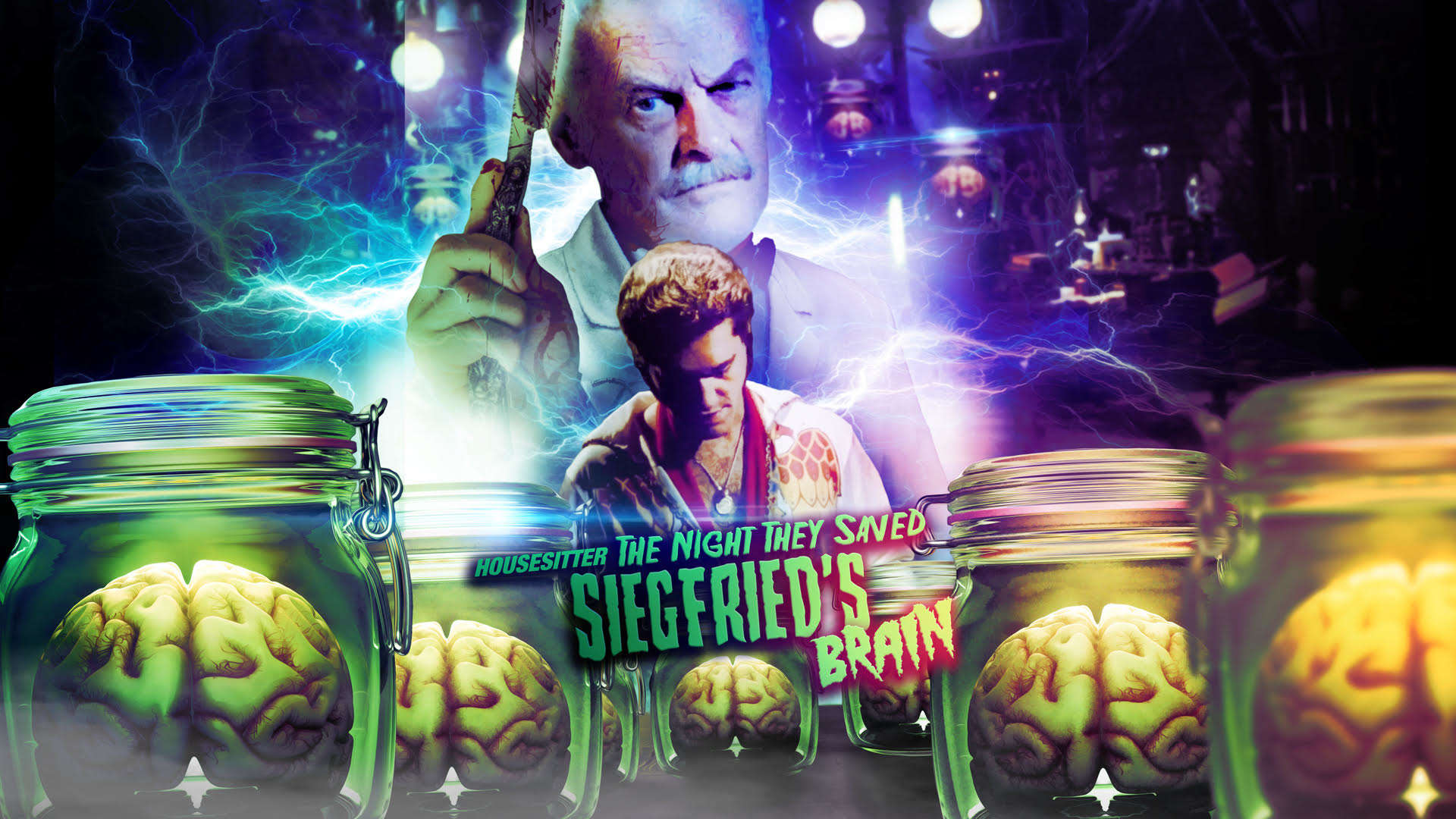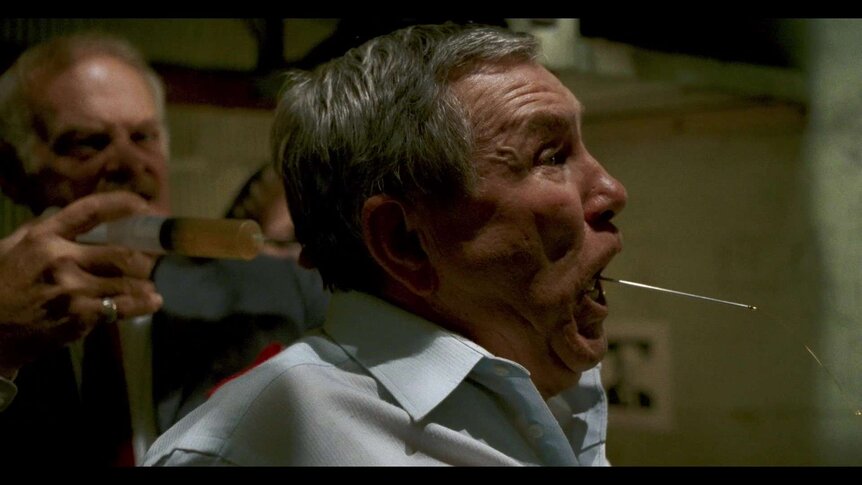Create a free profile to get unlimited access to exclusive videos, sweepstakes, and more!
How two filmmakers waited 30 years to see their brain-harvesting sci-fi slasher 'Housesitter' premiere

Too often, movies end up getting shelved after they are filmed. There are many reasons for this: The production company goes under and a new distributor needs to be found; a studio decides it isn’t worth putting any more time or money into it; or the producers simply run out of money to finish the project.
This is what happened with Housesitter: The Night They Saved Siegfried’s Brain. Writer/producer/star Richard Gasparian and writer/producer/director Robin Nuyen shot the film, but couldn’t come up with the money for post-production. The difference between Housesitter and other films lost to production hell is that it sat on a shelf for over 30 years before the creators were able to miraculously finish and release their film. With some help from Skywalker Sound and Paramount Pictures, Housesitter was restored from the original negative to a clean, 4K print.
Shot entirely in 1987, Housesitter: The Night They Saved Siegfried’s Brain is part slasher film, part homage to 1950s science fiction. Gasparian plays Andy, a medical student who is despondent when his brain-to-brain transfer experiment fails and he loses out on a chance to study abroad. His mentor, Doc, offers Andy a housesitting gig, knowing that college kids can’t resist throwing a party when left alone. Doc, of course, has an ulterior motive: To harvest the brains of 13 college kids so he can fulfill his experiment and save his own life.
SYFY WIRE spoke with Gasparian and Nuyen about shooting the film at 30, releasing it at 60, and the one minor, but important update they made before its release.
How did the idea for this movie come about?
Richard Gasparian: We were aspiring actors, out here in Los Angeles. We took jobs as PAs on the Fox lot. Part of our job was running errands, and we came across a big, empty soundstage. In the middle of that stage was a 1950s pedestal hairdryer. We kind of simultaneously looked at each other and said, “That looks like an old brain transfer machine!” Like out of those black and white 1950s sci-fi movies.
Robin Nuyen: It would make a great brain transfer machine, and we said it almost simultaneously while looking at each other.
Gasparian: It was kismet. That’s how it really started. We just kind of wrote the script and set about making the movie.
Nuyen: We stole the hairdryer. We threw it in the trunk and drove out of there. Richard is quite a driver, screeching tires and all, and we had a hairdryer that became a metaphor for what happened. We went out to the desert, put it in the middle of a cheap, cheap motel room, and we sat there with a couple of typewriters, and wrote the script with a pot of coffee and the hairdryer as inspiration. That hairdryer is the one we used in the movie.
How old were you guys when you wrote the script?
Gasparian: 29. We’re old guys now.
Nuyen: We were turning 30 when we made the film. We were being interviewed in Kalamazoo [where they filmed], and the [reporter] asks, “Why now?” One of us said, “We’re 30. It’s do or die at 30.” Literally, the headline in the newspaper the next day was “Filmmakers: Do or Die at 30.” That became a running gag. When we decided to finish the film at 60, it was do or die at 60!
Where did you end up shooting?
Gasparian: Kalamazoo, Michigan. Robin is from there, and we both went to college there. Kalamazoo is a very artistic, theatrical town. We took advantage of the fact that there were a lot of local actors and technicians we could use. The three older, lead actors were actually our college professors. We wrote the parts for them. Then Robin secured us the best house in Kalamazoo, which is called Henderson Castle. It’s like this haunted mansion. That served as the doctor’s house.
What was your budget?
Nuyen: I will take responsibility for why it is so high. The look of the film is just unbelievable because we shot it on 35mm, and ended up getting a 4K transfer off the original negative after it had been cleaned. We had picture by Paramount Studios and their post-production, then the sound from Skywalker. We are all very proud of the look and the sound of the film, for a low budget film. We spent, when all was said and done, about $300,000.
[As director] I kept saying, “Print it!” just because I liked the way it sounded. “Cut! Print it!” Our biggest expense of the movie was film processing, based on the fact that it was 35mm, and based on the fact that we were shooting in Kalamazoo and shipping it out [to Los Angeles]. We started out doing dailies, then we ended up doing weeklies — at the end we were doing monthlies.
The reason it ended up being more like weeklies, not dailies, was because Richard and I were too busy doing other stuff.
Gasparian: Too many hats! Not too many, but so many, we didn’t have time to watch the dailies.
How was it shooting in Kalamazoo?
Nuyen: There were so many great people in Kalamazoo helping out.
Gasparian: The town of Kalamazoo came out like you wouldn’t believe. They get a lot of credit for helping get the movie made, between lots of extras for party scenes, to lots of favors from businesses. It was back in the day when making a movie was kind of a novelty. In 1987, when we shot this, there hadn’t been any movies made in Kalamazoo, so it was a big deal for the town. It was a very symbiotic relationship. We got a lot of favors and we love them.
Nuyen: We often joke that the “thank you” credits are actually longer than the 93-minute film!
What prevented you from releasing the film until now?
Gasparian: We ran out of money. We wanted to make a low-budget horror movie — put 13 kids in a house and chop them up. But it grew. These things take on a life of their own. So it grew quite a bit, and we spent a lot more money than we planned on for production. It was going great. We met our payroll. But we basically ran out of money for post.
As first-time filmmakers, it is a treacherous world out there. We would go around looking for finishing money, and we would either find companies that loved our movie but couldn’t help us financially, who told us when we were done, come back to them; or we would find companies that would help us finish the movie, but we would have to sign it over to them. Our investors were family and friends. We couldn’t do that. It was a struggle. Both Robin and I were beat. We had taken a lot of punches on this.
But getting it out was brilliant. Over the years, we talked about finishing the movie. Robin had the guts to go to the lab and ask them if they had our negative. Unbelievably, they had the boxes. I remember Robin called me and said, “I’ve got the movie.” I couldn’t believe it.
Nuyen: That was in March 2016. I knew I couldn’t do it without Richard. You couldn’t get more simpatico than the two of us, from writing it to producing it. I directed, but he edited. We knew if we took that step [to finish], we weren’t stopping again. We had no idea that, ahead of us, was meeting someone from Skywalker, meeting someone from Paramount... all people who loved the movie, believed in the project, loved the story behind it: “30 years later and we haven’t given up.” They helped us finish the movie.
Gasparian: They were instrumental in helping us get it done.
Nuyen: The quality, the picture, and sound are all because of them. One afternoon, we are in the booth [at Skywalker Sound], and the next booth over was doing work on the new Star Wars movie. We could hear the brain transfers happening from our studio booth, and we could hear the lightsabers happening from the next studio.
Who do you see as the audience for this film? Young twentysomethings, or Gen Xers who grew up with 1980s slashers and are looking for a nice throwback?
Nuyen: I say 8 to 80. We’ve shown it at some film festivals, and we’ve shown a work print to those who worked on the film. In 1990 we did a rough cut of the film. And two years ago, we took first prize at the Thriller Chiller film festival. I had a friend who brought his dad, who was 97 years old — I can’t tell you how much he loved it! He loved the 1950s sci-fi. Other people like the horror. I had one guy say it was his favorite film since Evil Dead II. That guy was probably 25. You have the 1980s horror, and the 1950s sci-fi, but what Richard did with the editing, you have 2020 editing on a movie shot in 1987.
Is that why the parts in Doc’s lab are in black and white?
Gasparian: The reason there are some segments in black and white is that Robin and I grew up watching 1950s, 1960s sci-fi. The Brain That Wouldn’t Die, Them, all those great sci-fi movies. Now, we’ve got the 1980s things going on. The 1980s are pretty hot right now. But we’ve got the real thing.
Are there any updates to the film you had to make since the world has changed so much in the last 30 years?
Gasparian: That’s a good question. I think the only modern update we brought to it was the name of the asylum: Drumpf Asylum for the Criminally Insane.
Nuyen: It was Trump’s grandfather’s name. That’s the original family name.
Housesitter: The Night They Saved Siegfried’s Brain is currently available on VOD and Blu-ray. The filmmakers hope to screen at drive-ins during the pandemic.




























